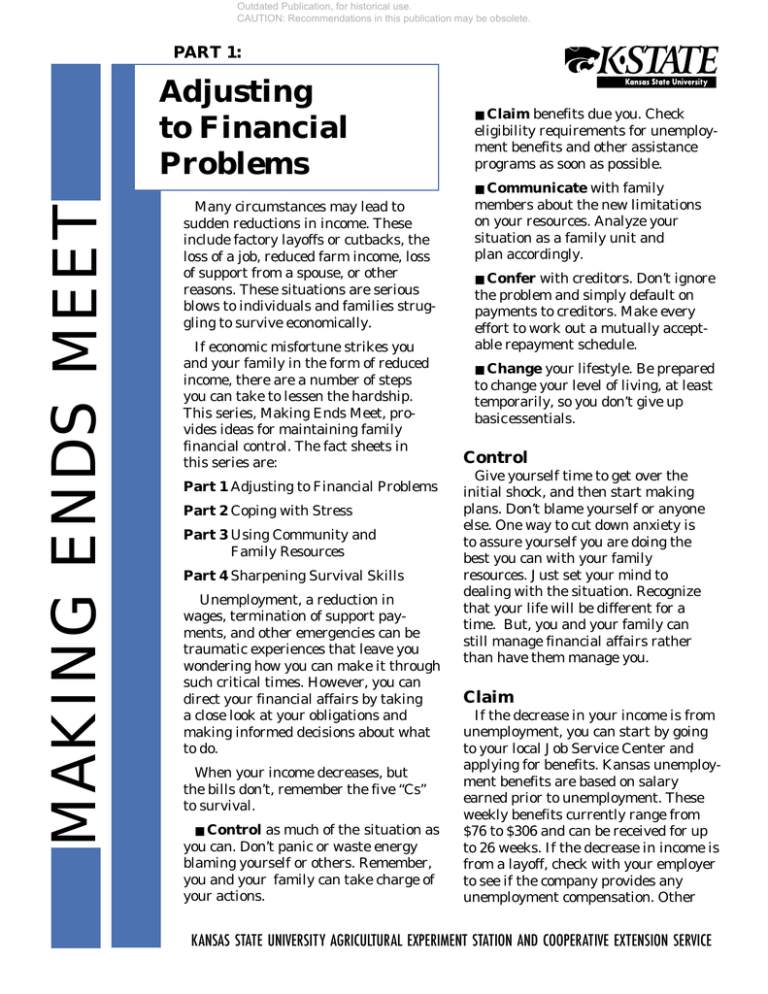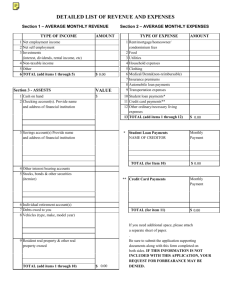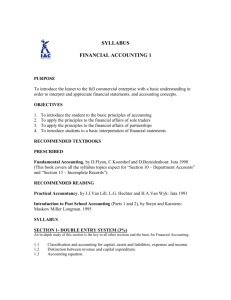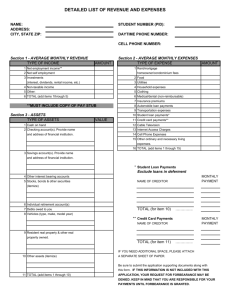
Outdated Publication, for historical use.
CAUTION: Recommendations in this publication may be obsolete.
PART 1:
MAKING ENDS MEET
Adjusting
to Financial
Problems
Many circumstances may lead to
sudden reductions in income. These
include factory layoffs or cutbacks, the
loss of a job, reduced farm income, loss
of support from a spouse, or other
reasons. These situations are serious
blows to individuals and families struggling to survive economically.
If economic misfortune strikes you
and your family in the form of reduced
income, there are a number of steps
you can take to lessen the hardship.
This series, Making Ends Meet, provides ideas for maintaining family
financial control. The fact sheets in
this series are:
Part 1 Adjusting to Financial Problems
Part 2 Coping with Stress
Part 3 Using Community and
Family Resources
Part 4 Sharpening Survival Skills
Unemployment, a reduction in
wages, termination of support payments, and other emergencies can be
traumatic experiences that leave you
wondering how you can make it through
such critical times. However, you can
direct your financial affairs by taking
a close look at your obligations and
making informed decisions about what
to do.
When your income decreases, but
the bills don’t, remember the five “Cs”
to survival.
■ Control as much of the situation as
you can. Don’t panic or waste energy
blaming yourself or others. Remember,
you and your family can take charge of
your actions.
Claim benefits due you. Check
eligibility requirements for unemployment benefits and other assistance
programs as soon as possible.
■
■ Communicate with family
members about the new limitations
on your resources. Analyze your
situation as a family unit and
plan accordingly.
Confer with creditors. Don’t ignore
the problem and simply default on
payments to creditors. Make every
effort to work out a mutually acceptable repayment schedule.
■
■ Change your lifestyle. Be prepared
to change your level of living, at least
temporarily, so you don’t give up
basic essentials.
Control
Give yourself time to get over the
initial shock, and then start making
plans. Don’t blame yourself or anyone
else. One way to cut down anxiety is
to assure yourself you are doing the
best you can with your family
resources. Just set your mind to
dealing with the situation. Recognize
that your life will be different for a
time. But, you and your family can
still manage financial affairs rather
than have them manage you.
Claim
If the decrease in your income is from
unemployment, you can start by going
to your local Job Service Center and
applying for benefits. Kansas unemployment benefits are based on salary
earned prior to unemployment. These
weekly benefits currently range from
$76 to $306 and can be received for up
to 26 weeks. If the decrease in income is
from a layoff, check with your employer
to see if the company provides any
unemployment compensation. Other
KANSAS STATE UNIVERSITY AGRICULTURAL EXPERIMENT STATION AND COOPERATIVE EXTENSION SERVICE
Outdated Publication, for historical use.
CAUTION: Recommendations in this publication may be obsolete.
PART 1:
MAKING ENDS MEET
Adjusting
to Financial
Problems
Many circumstances may lead to
sudden reductions in income. These
include factory layoffs or cutbacks, the
loss of a job, reduced farm income, loss
of support from a spouse, or other
reasons. These situations are serious
blows to individuals and families struggling to survive economically.
If economic misfortune strikes you
and your family in the form of reduced
income, there are a number of steps
you can take to lessen the hardship.
This series, Making Ends Meet, provides ideas for maintaining family
financial control. The fact sheets in
this series are:
Part 1 Adjusting to Financial Problems
Part 2 Coping with Stress
Part 3 Using Community and
Family Resources
Part 4 Sharpening Survival Skills
Unemployment, a reduction in
wages, termination of support payments, and other emergencies can be
traumatic experiences that leave you
wondering how you can make it through
such critical times. However, you can
direct your financial affairs by taking
a close look at your obligations and
making informed decisions about what
to do.
When your income decreases, but
the bills don’t, remember the five “Cs”
to survival.
■ Control as much of the situation as
you can. Don’t panic or waste energy
blaming yourself or others. Remember,
you and your family can take charge of
your actions.
Claim benefits due you. Check
eligibility requirements for unemployment benefits and other assistance
programs as soon as possible.
■
■ Communicate with family
members about the new limitations
on your resources. Analyze your
situation as a family unit and
plan accordingly.
Confer with creditors. Don’t ignore
the problem and simply default on
payments to creditors. Make every
effort to work out a mutually acceptable repayment schedule.
■
■ Change your lifestyle. Be prepared
to change your level of living, at least
temporarily, so you don’t give up
basic essentials.
Control
Give yourself time to get over the
initial shock, and then start making
plans. Don’t blame yourself or anyone
else. One way to cut down anxiety is
to assure yourself you are doing the
best you can with your family
resources. Just set your mind to
dealing with the situation. Recognize
that your life will be different for a
time. But, you and your family can
still manage financial affairs rather
than have them manage you.
Claim
If the decrease in your income is from
unemployment, you can start by going
to your local Job Service Center and
applying for benefits. Kansas unemployment benefits are based on salary
earned prior to unemployment. These
weekly benefits currently range from
$76 to $306 and can be received for up
to 26 weeks. If the decrease in income is
from a layoff, check with your employer
to see if the company provides any
unemployment compensation. Other
KANSAS STATE UNIVERSITY AGRICULTURAL EXPERIMENT STATION AND COOPERATIVE EXTENSION SERVICE
Outdated Publication, for historical use.
CAUTION: Recommendations in this publication may be obsolete.
resources that you could and should
consider are the Food Stamp Program,
Aid to Families with Dependent
Children (AFDC), General Assistance,
and Medical Assistance. These and
other resources will be discussed
further in Part 3: Using Community
and Family Resources.
Communicate
No matter why your income is reduced, you will need to know how much
money you will have to work with. Be
realistic. Include other family members
in the discussion. Consider all your
options. Is there another earner already
contributing to the family’s income?
Can the contribution be increased? Can
a nonemployed family member get a
temporary job? Can you use a hobby or
skill as a source of income?
Once you know how much income
will be coming in, make a list of your
expected expenses. Be sure all family
members participate in discussions
about expenditures. Decide what the
family needs next week, next month,
and during the next two to three
months. Delay buying items the family
would like to have but are not an
absolute necessity.
Discuss with family members the
types of expenses you have. Expenses
can be “fixed” or “flexible.” Flexible
expenses are those which vary in
amount and/or timing. Flexible
expenses are the first areas to look
at when you begin cutting costs.
For example, most clothing purchases
can be postponed, at least for a while.
Be creative and use your imagination
on how to cut expenditures and survive.
Fixed expenses are those that have a
set amount and must be paid by a set
date. These expenses, such as rent,
mortgage payments, some utilities,
installment debts, taxes, and insurance
premiums, are difficult to adjust. However, you may be able to rearrange or
renegotiate some fixed expenses by
communicating with the creditor.
2
Confer
After communicating with family
members, you will need to confer with
your creditors. Be sure to read all of
your credit contracts. Find out what
happens if you miss a payment. Is there
a grace period, a penalty for late payment, a repossession clause, or an
accelerated payment clause (full
amount is due immediately)? With this
knowledge, contact creditors before they
contact you. Whenever possible, confer
with the person in charge. Creditors
will be more likely to believe you and to
help you if you make this contact early.
When conferring with creditors, know
how much money you can count on,
what your fixed and flexible expenses
will be, and how long you expect your
income to be reduced. Present a reasonable plan for paying your debts. Then
work out an agreement with each
creditor that is acceptable to both
of you. You might find that you can
make smaller payments for a period of
time. When your income increases, go
back to the regular payment schedule.
Although this may increase the length
and total amount of your debt, it will
help ease the burden of a decreased
income. Above all, don’t ignore bills and
past due notices.
In some instances, you may not be
able to reach an agreement with all
your creditors. It’s usually wise to pay
creditors first who:
■ are
likely to attach your wages,
■
impose a high finance charge,
■
will repossess items,
■
will cut off a basic service, such as
utilities, or
■
are owed a large amount.
Other options to consider are refinancing an existing loan, getting a
consolidation loan, or bankruptcy.
Refinancing An Old Loan: An alternative to the problem of more debt than
income might be to refinance one loan—
make another contract for smaller
Outdated Publication, for historical use.
CAUTION: Recommendations in this publication may be obsolete.
payments over a longer period of time.
Remember, while the new payments
will be smaller in size, the overall cost
will be higher.
Consolidation Loan: A consolidation
loan is a new loan to pay off existing
debts with one monthly payment.
However, these loans involve higher
overall costs, with smaller payments
for a much longer period of time.
Bankruptcy: Bankruptcy is often a
last recourse. It is designed to help
persons with overwhelming debts and
spare them undue harassment by
creditors. While there is no hardand-fast rule, bankruptcy might
be a consideration if: (1) your
creditors are unwilling to renegotiate
debts; (2) you cannot obtain a
consolidation loan; (3) no other source
of help is available.
There are several choices in bankruptcy. Chapter 13 is designed for
persons with a source of regular income
who wish to pay their bills. They must
have less than $100,000 of unsecured
debts and less than $350,000 of secured
debts. Chapter 13 allows the debtor,
acting through a bankruptcy trustee, to
work out a whole or partial repayment
plan if half of all creditors agree. Payments are made to the court, and interest charges stop on the date of filing.
The payment schedule initially
stretches for a period of 36 months. A
Chapter 13 will remain on your credit
history for 7 years. Successful completion of the payment schedule will appear more favorable on a credit history
than a Chapter 7 bankruptcy.
Chapter 7 bankruptcy is called
“voluntary” or “straight” bankruptcy.
A petition that includes a list of all
assets and liabilities is filed. The court
liquidates major assets, with the
exception of certain personal possessions, and distributes funds to creditors.
A Chapter 7 remains on your credit
history for 10 years. The potential
stigma of bankruptcy should be
considered very carefully.
Change
Survival in hard times often requires
many changes and adjustments. Reducing expenses is a major change. Pay
particular attention to transportation,
food, household expenses, entertainment, recreation, and clothing.
Look for ways that you and family
members can use time, energy, talents,
and knowledge to reduce other expenses. Take better care of the things
you already possess. Recycle clothing.
Swap items and services with a friend
or neighbor. Plant a garden or produce
items normally purchased. Use community resources available to you such as
food stamps, utility assistance, and
health clinics. These suggestions will
decrease the amount of money that
must be spent on necessary items. They
will not help you continue your normal
level of living, but they will help you
through the hard times.
To make it through hard times, your
family will need to make informed
decisions and work together to carry
out these decisions. A family commitment to the five “Cs”—control, claim,
communicate, confer, and change—
will help handle tough financial
situations better.
References
Lieurance, Eunice, and Mindy Martin, “What To Do If You’re Faced With
Unemployment,” University of Missouri, Extension Division.
Bankston, Joanne, “When Your
Income Decreases...But The Bills
Don’t,” Kentucky State University,
Cooperative Extension Program,
May 1983.
Kramer, Carol S., “When Your Income
Drops,” Kansas State University,
Cooperative Extension Service, 1982.
Prepared by Wilma Schuh,
Extension Assistant; Doris “Katey”
Walker, Extension Specialist, Family
Resources and Public Policy; and Joyce
E. Jones, Extension Specialist, Family
Financial Management.
3
Outdated Publication, for historical use.
CAUTION: Recommendations in this publication may be obsolete.
Brand names appearing in this publication are for product identification purposes only. No endorsement is intended,
nor is criticism implied of similar products not mentioned.
Contents of this publication may be freely reproduced for educational purposes. All other rights reserved. In each
case, credit Wilma Schuh, Doris "Katey" Walker, and Joyce E. Jones, "Making Ends Meet: Adjusting to Financial
Problems," Kansas State University, March 1990.
L-809
March 1990
Kansas State University Agricultural Experiment Station and Cooperative Extension Service
It is the policy of Kansas State University Agricultural Experiment Station and Cooperative Extension Service that all persons
shall have equal opportunity and access to its educational programs, services, activities, and materials without regard to race,
color, religion, national origin, sex, age or disability. Kansas State University is an equal opportunity organization. Issued in
furtherance of Cooperative Extension Work, Acts of May 8 and June 30, 1914, as amended. Kansas State University, County
Extension Councils, Extension Districts, and United States Department of Agriculture Cooperating, Marc A. Johnson, Director.
4
Outdated Publication, for historical use.
CAUTION: Recommendations in this publication may be obsolete.
resources that you could and should
consider are the Food Stamp Program,
Aid to Families with Dependent
Children (AFDC), General Assistance,
and Medical Assistance. These and
other resources will be discussed
further in Part 3: Using Community
and Family Resources.
Communicate
No matter why your income is reduced, you will need to know how much
money you will have to work with. Be
realistic. Include other family members
in the discussion. Consider all your
options. Is there another earner already
contributing to the family’s income?
Can the contribution be increased? Can
a nonemployed family member get a
temporary job? Can you use a hobby or
skill as a source of income?
Once you know how much income
will be coming in, make a list of your
expected expenses. Be sure all family
members participate in discussions
about expenditures. Decide what the
family needs next week, next month,
and during the next two to three
months. Delay buying items the family
would like to have but are not an
absolute necessity.
Discuss with family members the
types of expenses you have. Expenses
can be “fixed” or “flexible.” Flexible
expenses are those which vary in
amount and/or timing. Flexible
expenses are the first areas to look
at when you begin cutting costs.
For example, most clothing purchases
can be postponed, at least for a while.
Be creative and use your imagination
on how to cut expenditures and survive.
Fixed expenses are those that have a
set amount and must be paid by a set
date. These expenses, such as rent,
mortgage payments, some utilities,
installment debts, taxes, and insurance
premiums, are difficult to adjust. However, you may be able to rearrange or
renegotiate some fixed expenses by
communicating with the creditor.
2
Confer
After communicating with family
members, you will need to confer with
your creditors. Be sure to read all of
your credit contracts. Find out what
happens if you miss a payment. Is there
a grace period, a penalty for late payment, a repossession clause, or an
accelerated payment clause (full
amount is due immediately)? With this
knowledge, contact creditors before they
contact you. Whenever possible, confer
with the person in charge. Creditors
will be more likely to believe you and to
help you if you make this contact early.
When conferring with creditors, know
how much money you can count on,
what your fixed and flexible expenses
will be, and how long you expect your
income to be reduced. Present a reasonable plan for paying your debts. Then
work out an agreement with each
creditor that is acceptable to both
of you. You might find that you can
make smaller payments for a period of
time. When your income increases, go
back to the regular payment schedule.
Although this may increase the length
and total amount of your debt, it will
help ease the burden of a decreased
income. Above all, don’t ignore bills and
past due notices.
In some instances, you may not be
able to reach an agreement with all
your creditors. It’s usually wise to pay
creditors first who:
■ are
likely to attach your wages,
■
impose a high finance charge,
■
will repossess items,
■
will cut off a basic service, such as
utilities, or
■
are owed a large amount.
Other options to consider are refinancing an existing loan, getting a
consolidation loan, or bankruptcy.
Refinancing An Old Loan: An alternative to the problem of more debt than
income might be to refinance one loan—
make another contract for smaller
Outdated Publication, for historical use.
CAUTION: Recommendations in this publication may be obsolete.
payments over a longer period of time.
Remember, while the new payments
will be smaller in size, the overall cost
will be higher.
Consolidation Loan: A consolidation
loan is a new loan to pay off existing
debts with one monthly payment.
However, these loans involve higher
overall costs, with smaller payments
for a much longer period of time.
Bankruptcy: Bankruptcy is often a
last recourse. It is designed to help
persons with overwhelming debts and
spare them undue harassment by
creditors. While there is no hardand-fast rule, bankruptcy might
be a consideration if: (1) your
creditors are unwilling to renegotiate
debts; (2) you cannot obtain a
consolidation loan; (3) no other source
of help is available.
There are several choices in bankruptcy. Chapter 13 is designed for
persons with a source of regular income
who wish to pay their bills. They must
have less than $100,000 of unsecured
debts and less than $350,000 of secured
debts. Chapter 13 allows the debtor,
acting through a bankruptcy trustee, to
work out a whole or partial repayment
plan if half of all creditors agree. Payments are made to the court, and interest charges stop on the date of filing.
The payment schedule initially
stretches for a period of 36 months. A
Chapter 13 will remain on your credit
history for 7 years. Successful completion of the payment schedule will appear more favorable on a credit history
than a Chapter 7 bankruptcy.
Chapter 7 bankruptcy is called
“voluntary” or “straight” bankruptcy.
A petition that includes a list of all
assets and liabilities is filed. The court
liquidates major assets, with the
exception of certain personal possessions, and distributes funds to creditors.
A Chapter 7 remains on your credit
history for 10 years. The potential
stigma of bankruptcy should be
considered very carefully.
Change
Survival in hard times often requires
many changes and adjustments. Reducing expenses is a major change. Pay
particular attention to transportation,
food, household expenses, entertainment, recreation, and clothing.
Look for ways that you and family
members can use time, energy, talents,
and knowledge to reduce other expenses. Take better care of the things
you already possess. Recycle clothing.
Swap items and services with a friend
or neighbor. Plant a garden or produce
items normally purchased. Use community resources available to you such as
food stamps, utility assistance, and
health clinics. These suggestions will
decrease the amount of money that
must be spent on necessary items. They
will not help you continue your normal
level of living, but they will help you
through the hard times.
To make it through hard times, your
family will need to make informed
decisions and work together to carry
out these decisions. A family commitment to the five “Cs”—control, claim,
communicate, confer, and change—
will help handle tough financial
situations better.
References
Lieurance, Eunice, and Mindy Martin, “What To Do If You’re Faced With
Unemployment,” University of Missouri, Extension Division.
Bankston, Joanne, “When Your
Income Decreases...But The Bills
Don’t,” Kentucky State University,
Cooperative Extension Program,
May 1983.
Kramer, Carol S., “When Your Income
Drops,” Kansas State University,
Cooperative Extension Service, 1982.
Prepared by Wilma Schuh,
Extension Assistant; Doris “Katey”
Walker, Extension Specialist, Family
Resources and Public Policy; and Joyce
E. Jones, Extension Specialist, Family
Financial Management.
3
Outdated Publication, for historical use.
CAUTION: Recommendations in this publication may be obsolete.
Brand names appearing in this publication are for product identification purposes only. No endorsement is intended,
nor is criticism implied of similar products not mentioned.
Contents of this publication may be freely reproduced for educational purposes. All other rights reserved. In each
case, credit Wilma Schuh, Doris "Katey" Walker, and Joyce E. Jones, "Making Ends Meet: Adjusting to Financial
Problems," Kansas State University, March 1990.
L-809
Kansas State University Agricultural Experiment Station and Cooperative Extension Service
March 1990
It is the policy of Kansas State University Agricultural Experiment Station and Cooperative Extension Service that all persons
shall have equal opportunity and access to its educational programs, services, activities, and materials without regard to race,
color, religion, national origin, sex, age or disability. Kansas State University is an equal opportunity organization. Issued in
furtherance of Cooperative Extension Work, Acts of May 8 and June 30, 1914, as amended. Kansas State University, County
Extension Councils, Extension Districts, and United States Department of Agriculture Cooperating, Marc A. Johnson, Director.
4




